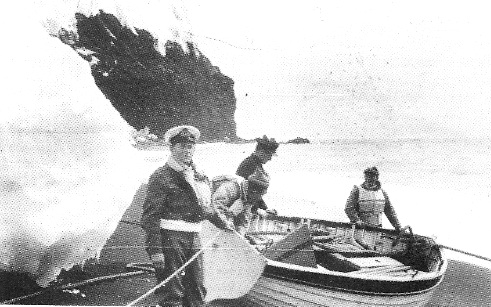

They were also the first to accurately fix the island's position. They were not able to land, but dredged the seabed for geological samples. German Carl Chun's Valdivia Expedition arrived at the island in 1898. : 63 The next expedition to spot the island was Joseph Fuller and his ship Francis Allyn in 1893, but he was not able to land on the island. On 10 December 1825, SE&S's George Norris, master of the Sprightly, landed on the island, : 62 named it Liverpool Island and claimed it for the British Crown and George IV on 16 December. : 106–107 This has caused some commentators to doubt whether he actually visited the island. : 62 In his subsequent lengthy description, Morrell does not mention the island's most obvious physical feature: Its permanent ice cover. Morrell, by his own account, found the island without difficulty (with "improbable ease", in the words of historian William Mills) : 434–435 before landing and hunting 196 seals. : 62 The next expedition to arrive at the island was American Benjamin Morrell and his seal hunting ship Wasp. : 434–435 Lindsay could confirm that the "cape" was indeed an island. Swan and another Enderby whaler, Otter were in company when they reached the island and recorded its position, though they were unable to land. The next expedition to spot the island was in 1808 by James Lindsay, captain of the Samuel Enderby & Sons' (SE&S) snow whaler Swan.

: 58 James Cook's second voyage set off from Cape Verde on 22 November 1772 and attempted to find the island, but also failed. : 62 His plotting of its position was inaccurate, : 47 leading several expeditions to fail to find the island. He was not able to land and did not circumnavigate his discovery, thus not clarifying if it was an island or part of a continent. Bouvet, who was searching for a presumed large southern continent, spotted the island through the fog and named the cape he saw Cap de la Circoncision. The island was discovered on 1 January 1739 (283 years ago) ( ) by Jean-Baptiste Charles Bouvet de Lozier, commander of the French ships Aigle and Marie. In 1971, it was designated a nature reserve. In 1930, following resolution of a dispute with the United Kingdom over claiming rights, it was declared a Norwegian dependency. At that point, the island was given its current name of Bouvet Island ("Bouvetøya" in Norwegian). In 1927, the first Norvegia expedition landed on the island, and claimed it for Norway. He also reported having sighted another island nearby, which he named Thompson Island, but this was later shown to be a phantom island. In 1825, the island was claimed for the British Crown by George Norris, who named it Liverpool Island. The first claim to have landed on the island was made by the American sailor Benjamin Morrell, although this claim is disputed. He mislabeled the coordinates for the island, and it was not sighted again until 1808, when the British whaler James Lindsay encountered it and named it Lindsay Island. The island was first spotted on 1 January 1739 by the Frenchman Jean-Baptiste Charles Bouvet de Lozier, during a French exploration mission in the South Atlantic with the ships Aigle and Marie. Nyrøysa, created by a rock slide in the late 1950s, is the only easy place to land and is the location of a weather station. Some skerries and one smaller island, Larsøya, lie along its coast. The centre of the island is the ice-filled crater of an inactive volcano. It has an area of 49 square kilometres (19 sq mi), 93 percent of which is covered by a glacier. The island lies 1,700 kilometres (1,100 mi) north of the Princess Astrid Coast of Queen Maud Land, Antarctica, 1,900 kilometres (1,200 mi) east of the South Sandwich Islands, 1,600 kilometres (990 mi) south of Gough Island, and 2,600 kilometres (1,600 mi) south-southwest of the coast of South Africa. It is not part of the southern region covered by the Antarctic Treaty System.


It is a subantarctic volcanic island, situated in the South Atlantic Ocean at the southern end of the Mid-Atlantic Ridge, making it the world's most remote island. IUCN category Ia ( strict nature reserve)īouvet Island ( / ˈ b uː v eɪ/ boo- VAY Norwegian: Bouvetøya or Bouvetøyen) is an island claimed by Norway, and declared an uninhabited protected nature reserve.


 0 kommentar(er)
0 kommentar(er)
